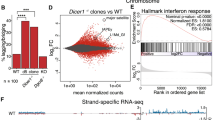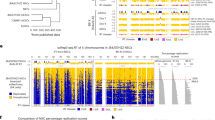Abstract
The organization of eukaryotic genomes into distinct structural and functional domains is important for the regulation and transduction of genetic information. Here, we investigated heterochromatin and euchromatin profiles of the entire fission yeast genome and explored the role of RNA interference (RNAi) in genome organization. Histone H3 methylated at Lys4, which defines euchromatin, was not only distributed across most of the chromosomal landscape but was also present at the centromere core, the site of kinetochore assembly. In contrast, histone H3 methylated at Lys9 and its interacting protein Swi6/HP1, which define heterochromatin, coated extended domains associated with a variety of repeat elements and small islands corresponding to meiotic genes. Notably, RNAi components were distributed throughout all these heterochromatin domains, and their localization depended on Clr4/Suv39h histone methyltransferase. Sequencing of small interfering RNAs (siRNAs) associated with the RITS RNAi effector complex identified hot spots of siRNAs, which mapped to a diverse array of elements in these RNAi-heterochromatin domains. We found that Clr4/Suv39h predominantly silenced repeat elements whose derived transcripts, transcribed mainly by RNA polymerase II, serve as a source for siRNAs. Our analyses also uncover an important role for the RNAi machinery in maintaining genomic integrity.
This is a preview of subscription content, access via your institution
Access options
Subscribe to this journal
Receive 12 print issues and online access
$209.00 per year
only $17.42 per issue
Buy this article
- Purchase on Springer Link
- Instant access to full article PDF
Prices may be subject to local taxes which are calculated during checkout








Similar content being viewed by others
References
Noma, K., Allis, C.D. & Grewal, S.I.S. Transitions in distinct histone H3 methylation patterns at the heterochromatin domain boundaries. Science 293, 1150–1155 (2001).
Litt, M.D., Simpson, M., Gaszner, M., Allis, C.D. & Felsenfeld, G. Correlation between histone lysine methylation and developmental changes at the chicken beta-globin locus. Science 293, 2453–2455 (2001).
Rea, S. et al. Regulation of chromatin structure by site-specific histone H3 methyltransferases. Nature 406, 593–599 (2000).
Nakayama, J., Rice, J.C., Strahl, B.D., Allis, C.D. & Grewal, S.I.S. Role of histone H3 lysine 9 methylation in epigenetic control of heterochromatin assembly. Science 292, 110–113 (2001).
Bannister, A.J. et al. Selective recognition of methylated lysine 9 on histone H3 by the HP1 chromo domain. Nature 410, 120–124 (2001).
Hall, I.M. et al. Establishment and maintenance of a heterochromatin domain. Science 297, 2232–2237 (2002).
Lachner, M., O'Sullivan, R.J. & Jenuwein, T. An epigenetic road map for histone lysine methylation. J. Cell Sci. 116, 2117–2124 (2003).
Grewal, S.I. & Rice, J.C. Regulation of heterochromatin by histone methylation and small RNAs. Curr. Opin. Cell Biol. 16, 230–238 (2004).
Mochizuki, K. & Gorovsky, M.A. Small RNAs in genome rearrangement in Tetrahymena. Curr. Opin. Genet. Dev. 14, 181–187 (2004).
Chan, S.W., Henderson, I.R. & Jacobsen, S.E. Gardening the genome: DNA methylation in Arabidopsis thaliana. Nat. Rev. Genet. 6, 351–360 (2005).
Matzke, M.A. & Birchler, J.A. RNAi-mediated pathways in the nucleus. Nat. Rev. Genet. 6, 24–35 (2005).
Volpe, T.A. et al. Regulation of heterochromatic silencing and histone H3 lysine-9 methylation by RNAi. Science 297, 1833–1837 (2002).
Verdel, A. et al. RNAi-mediated targeting of heterochromatin by the RITS complex. Science 303, 672–676 (2004).
Noma, K. et al. RITS acts in cis to promote RNA interference-mediated transcriptional and post-transcriptional silencing. Nat. Genet. 36, 1174–1180 (2004).
Motamedi, M.R. et al. Two RNAi complexes, RITS and RDRC, physically interact and localize to noncoding centromeric RNAs. Cell 119, 789–802 (2004).
Sugiyama, T., Cam, H., Verdel, A., Moazed, D. & Grewal, S.I.S. RNA-dependent RNA polymerase is an essential component of a self-enforcing loop coupling heterochromatin assembly to siRNA production. Proc. Natl. Acad. Sci. USA 102, 152–157 (2005).
Lippman, Z. et al. Role of transposable elements in heterochromatin and epigenetic control. Nature 430, 471–476 (2004).
Martens, J.H. et al. The profile of repeat-associated histone lysine methylation states in the mouse epigenome. EMBO J. 24, 800–812 (2005).
Wood, V. et al. The genome sequence of Schizosaccharomyces pombe. Nature 415, 871–880 (2002).
Sadaie, M., Iida, T., Urano, T. & Nakayama, J. A chromodomain protein, Chp1, is required for the establishment of heterochromatin in fission yeast. EMBO J. 23, 3825–3835 (2004).
Schramke, V. & Allshire, R. Hairpin RNAs and retrotransposon LTRs effect RNAi and chromatin-based gene silencing. Science 301, 1069–1074 (2003).
Nielsen, S.J. et al. Rb targets histone H3 methylation and HP1 to promoters. Nature 412, 561–565 (2001).
Jia, S., Yamada, T. & Grewal, S.I.S. Heterochromatin regulates cell type-specific long-range chromatin interactions essential for directed recombination. Cell 119, 469–480 (2004).
Partridge, J.F., Borgstrom, B. & Allshire, R.C. Distinct protein interaction domains and protein spreading in a complex centromere. Genes Dev. 14, 783–791 (2000).
Takahashi, K., Chen, E.S. & Yanagida, M. Requirement of Mis6 centromere connector for localizing a CENP-A-like protein in fission yeast. Science 288, 2215–2219 (2000).
Henikoff, S., Ahmad, K., Platero, J.S. & van Steensel, B. Heterochromatic deposition of centromeric histone H3-like proteins. Proc. Natl. Acad. Sci. USA 97, 716–721 (2000).
Mandell, J.G., Bahler, J., Volpe, T.A., Martienssen, R.A. & Cech, T.R. Global expression changes resulting from loss of telomeric DNA in fission yeast. Genome Biol. 6, R1 (2005).
Thon, G. & Verhein-Hansen, J. Four chromo-domain proteins of Schizosaccharomyces pombe differentially repress transcription at various chromosomal locations. Genetics 155, 551–568 (2000).
Shankaranarayana, G.D., Motamedi, M.R., Moazed, D. & Grewal, S.I.S. Sir2 regulates histone H3 lysine 9 methylation and heterochromatin assembly in fission yeast. Curr. Biol. 13, 1240–1246 (2003).
Hansen, K.R. et al. Global effects on gene expression in fission yeast by silencing and RNA interference machineries. Mol. Cell. Biol. 25, 590–601 (2005).
Bowen, N.J., Jordan, I.K., Epstein, J.A., Wood, V. & Levin, H.L. Retrotransposons and their recognition of pol II promoters: a comprehensive survey of the transposable elements from the complete genome sequence of Schizosaccharomyces pombe. Genome Res. 13, 1984–1997 (2003).
Sullivan, B.A. & Karpen, G.H. Centromeric chromatin exhibits a histone modification pattern that is distinct from both euchromatin and heterochromatin. Nat. Struct. Mol. Biol. 11, 1076–1083 (2004).
Petrie, V.J., Wuitschick, J.D., Givens, C.D., Kosinski, A.M. & Partridge, J.F. RNA interference (RNAi)-dependent and RNAi-independent association of the Chp1 chromodomain protein with distinct heterochromatic loci in fission yeast. Mol. Cell. Biol. 25, 2331–2346 (2005).
Baulcombe, D. RNA silencing in plants. Nature 431, 356–363 (2004).
Llave, C., Kasschau, K.D., Rector, M.A. & Carrington, J.C. Endogenous and silencing-associated small RNAs in plants. Plant Cell 14, 1605–1619 (2002).
Aravin, A.A. et al. The small RNA profile during Drosophila melanogaster development. Dev. Cell 5, 337–350 (2003).
Schwarz, D.S. et al. Asymmetry in the assembly of the RNAi enzyme complex. Cell 115, 199–208 (2003).
Tomari, Y., Matranga, C., Haley, B., Martinez, N. & Zamore, P.D. A protein sensor for siRNA asymmetry. Science 306, 1377–1380 (2004).
Reinhart, B.J. & Bartel, D.P. Small RNAs correspond to centromere heterochromatic repeats. Science 297, 1831 (2002).
Jia, S., Noma, K. & Grewal, S.I.S. RNAi-independent heterochromatin nucleation by the stress-activated ATF/CREB family proteins. Science 304, 1971–1976 (2004).
Kanoh, J. & Ishikawa, F. spRap1 and spRif1, recruited to telomeres by Taz1, are essential for telomere function in fission yeast. Curr. Biol. 11, 1624–1630 (2001).
Xie, Z. et al. Genetic and functional diversification of small RNA pathways in plants. PLoS Biol. 2, E104 (2004).
Sijen, T. & Plasterk, R.H. Transposon silencing in the Caenorhabditis elegans germ line by natural RNAi. Nature 426, 310–314 (2003).
Hall, I.M., Noma, K. & Grewal, S.I.S. RNA interference machinery regulates chromosome dynamics during mitosis and meiosis in fission yeast. Proc. Natl. Acad. Sci. USA 100, 193–198 (2003).
Maison, C. et al. Higher-order structure in pericentric heterochromatin involves a distinct pattern of histone modification and an RNA component. Nat. Genet. 30, 329–334 (2002).
Herr, A.J., Jensen, M.B., Dalmay, T. & Baulcombe, D.C. RNA polymerase IV directs silencing of endogenous DNA. Science 308, 118–120 (2005).
Onodera, Y. et al. Plant nuclear RNA polymerase IV mediates siRNA and DNA methylation-dependent heterochromatin formation. Cell 120, 613–622 (2005).
Kanno, T. et al. Atypical RNA polymerase subunits required for RNA-directed DNA methylation. Nat. Genet., advance online publication 29 May 2005 (10.1038/ng1580).
Elbashir, S.M., Lendeckel, W. & Tuschl, T. RNA interference is mediated by 21- and 22-nucleotide RNAs. Genes Dev. 15, 188–200 (2001).
Acknowledgements
We thank K. Shirahige, Y. Katou and M. Kawano for contributions; M. Lichten, B. Paterson and K. Noma for critical reading; and other members of the laboratory of S.I.S.G. for discussions. T.S. is a JSPS Research Fellow in Biomedical and Behavioral Research at the US National Institutes of Health. This study used the high-performance computational capabilities of the Helix Systems at the National Institutes of Health (http://helix.nih.gov).
Author information
Authors and Affiliations
Corresponding author
Ethics declarations
Competing interests
The authors declare no competing financial interests.
Supplementary information
Supplementary Fig. 1
Scatter plots of H3K9me and H3K4me ChIP-on-chip analyses. (PDF 29 kb)
Supplementary Fig. 2
RITS and Rdp1 distribute throughout the silent mating-type interval. (PDF 29 kb)
Supplementary Fig. 3
SPAC212.11 transcription is regulated by RNAi and heterochromatin machineries. (PDF 66 kb)
Supplementary Table 1
Increased frequency of mitotic recombination at tandem rDNA in RNAi and clr4 mutants. (PDF 21 kb)
Rights and permissions
About this article
Cite this article
Cam, H., Sugiyama, T., Chen, E. et al. Comprehensive analysis of heterochromatin- and RNAi-mediated epigenetic control of the fission yeast genome. Nat Genet 37, 809–819 (2005). https://doi.org/10.1038/ng1602
Received:
Accepted:
Published:
Issue Date:
DOI: https://doi.org/10.1038/ng1602
This article is cited by
-
The regional sequestration of heterochromatin structural proteins is critical to form and maintain silent chromatin
Epigenetics & Chromatin (2022)
-
The inner nuclear membrane protein Lem2 coordinates RNA degradation at the nuclear periphery
Nature Structural & Molecular Biology (2022)
-
Histone deacetylation primes self-propagation of heterochromatin domains to promote epigenetic inheritance
Nature Structural & Molecular Biology (2022)
-
Spreading-dependent or independent Sir2-mediated gene silencing in budding yeast
Genes & Genomics (2022)
-
Chromatin accessibility profiling in Neurospora crassa reveals molecular features associated with accessible and inaccessible chromatin
BMC Genomics (2021)



